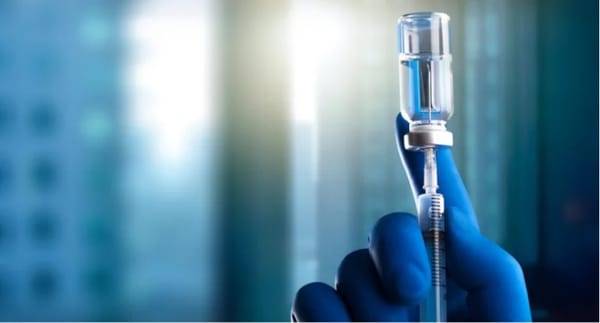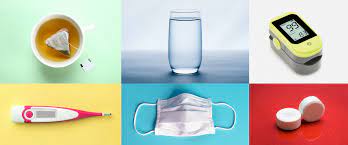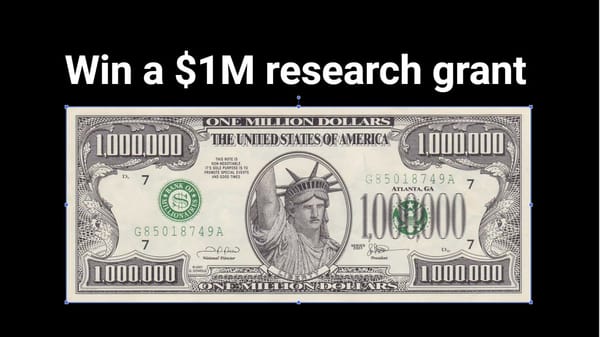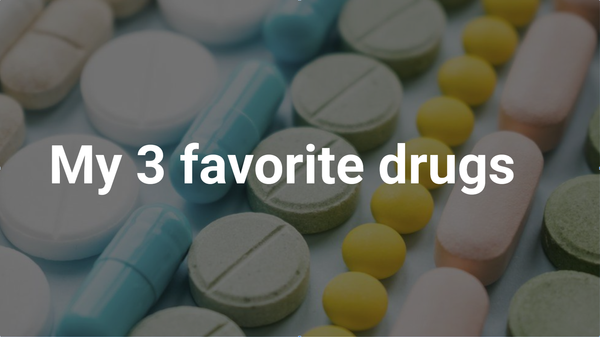This inexpensive, FDA-approved drug can significantly reduce the hospitalization and death rate from COVID-19
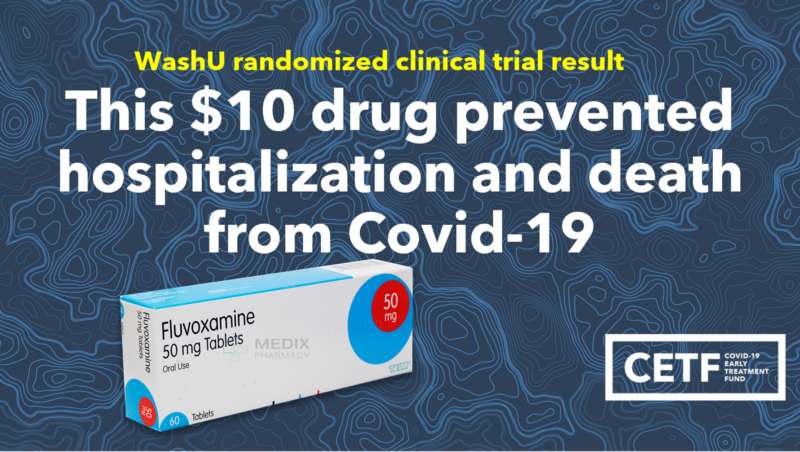
In a double-blinded randomized controlled clinical trial (n=152), Fluvoxamine completely prevented hospitalization and death from COVID-19 for those who took the drug (N=80) vs. placebo (N=72 with 6 meeting the hospitalization endpoint 8.3% ) p=.009. A study done a few weeks after that study was published also had a 100% success rate in preventing hospitalization for everyone treated (N=62) vs. a 10% hospitalization rate for those refusing to take the drug (N=52).
It's clear that we now have an inexpensive, FDA-approved drug that can reduce the hospitalization and death rate from COVID-19 … but only if we start using it now
Summary: On November 12, the fluvoxamine RCT was the lead article on JAMA.
The JAMA editors wrote that because the study was small, it should not be used as a basis for clinical decision making until it is confirmed. This is standard medical practice.
I will show in this article why I believe that advice, in this particular case, is a tragic mistake. When you consider all the outstanding evidence, you come to a different conclusion.
A few doctors ignored the JAMA advice. All of those who have, as of Jan 17, 2021, that I am aware of, achieved similar 100% protective results, just like in the trial.
This article makes the case that the sum total of all the evidence is both clear and convincing that there is a large effect here and it cannot be explained away by a confounder or two.
Because people’s lives are at stake until a vaccine is distributed to everyone, for those who get infected in the meantime, I believe the evidence, both pro and con, about this drug should be proactively presented by physicians to their patients for their consideration and let the patient decide. This article was written to help patients weigh the arguments.
I am not aware of any evidence that the drug is likely to be more harmful than beneficial. The worst side effect at 50mg BID dosing is mild nausea in one patient that I'm aware of.
This article was written to help patients interpret the data.
On October 6, at a virtual conference on Therapeutics for COVID-19 sponsored by the International Society for Influenza and other Respiratory Virus Diseases (ISIRV), researchers from Washington University in St. Louis reported that the antidepressant fluvoxamine, when taken within 7 days after first symptoms, reduced the hospitalization rate due to COVID-19 to zero versus an 8.3% hospitalization rate for those patients (n=72) who were given a placebo (p=.009).
This is a stunning result. While the paper calls this an 8.3% absolute delta, that is compared to 0%. So instead of 100,000 people being hospitalized, the result means 0 people would be hospitalized. However, in doing a larger study we may find that the drug only reduces the hospitalization rate by 75% (which is still game-changing). We won’t know the exact number until we do a larger study.
Although the numbers in the trial were relatively small (152 patients) this result confirmed an earlier observational study done in France that discovered the linkage and suggested a confirmatory double blind study be done. So we now have confirmed that an inexpensive drug that can dramatically reduce hospitalization and death due to COVID-19. While we cannot pinpoint the exact reduction, the evidence we have today is that the improvement is large; the exact number doesn’t matter: it’s very significant and it’s better than the current alternatives.
Although a press release announcing the result was sent on the standard wire service on October 6, the press didn’t cover the story. Even after JAMA published the fluvoxamine study on November 12 and called it out in a separate Editor’s Note as one of the very few studies worthy of publication in JAMA, the mainstream press by and large ignored it.
We are in the middle of a pandemic which is getting worse every day. In this particular case, it doesn’t seem wise to withhold this information from the public. We have a credible result from a credible researcher and institution that aligns perfectly with results of other researchers that can save people’s lives, we have a duty to report those results and let the public decide. And we have validation in the field (e.g., at the 200 person outbreak at Golden Gate Fields) with the same 100% protection.
Here are my top 24 reasons why you should consider fluvoxamine if you are diagnosed with COVID. You only need to believe one of the reasons to justify talking to your doctor.
- We are experiencing a huge rise in hospitalization and death. This drug can benefit us IMMEDIATELY: Over 5,000 people worldwide every day are dying from this virus. Fourteen states recently set virus hospitalization records. This drug is taken within 7 days of first symptoms and it prevented hospitalization for everyone that took it. Even if it results in “only” a 85% reduction in hospitalization, that is very significant.
- Lenze's RCT results were replicated independently with identical stats: After the RCT was published, there was a massive COVID outbreak at Golden Gates Fields in Berkeley, CA. Starting on November 21, Dr. David Seftel offered the first 100 employees who were PCR positive a choice of fluvoxamine or nothing. The half the employees opted for fluvoxamine, without exception, enjoyed very mild disease, superior cognitive ability, and avoided hospitalization. The half who refused treatment had a much more difficult time with the virus with 10% admitted to the hospital. As of December 5, 100% of newly infected cases are opting for the fluvoxamine. These people weren’t sold by doctors or p-values (which is now .0003, which is two orders of magnitude greater than statistical significance); they were convinced by seeing how their peers who got the medicine did. Nobody has any doubts now because they see it with their own eyes.
- The drug is off-the-shelf, cheap, and is available immediately. Doctors can start prescribing this today (off-label) because fluvoxamine is already FDA approved. No EUA is required.
- The effectiveness is better than any treatment available today. None of the 80 people who took the drug needed to be hospitalized. By contrast, 6 of the 72 people who got the placebo (8.3%) met the hospitalization criteria (SpO2 92% or need for supplemental oxygen). No other double-blind randomized clinical trial from anywhere in the world has reported such dramatic results. In fact, the WHO Solidarity trial recently reported that none of the drugs they tested had any impact on outcomes.
- One of the world’s top coronavirus experts had this to say. “The preliminary data suggests the mechanism involves activation of the sigma-1 receptor, which has a number of documented activities. One strong possibility is that activation dampens cytokine release and thus the inflammatory response. Other possible mechanisms include inhibition of platelet activation and modulation of autophagy. Coronaviruses usurp some autophagy machinery to remodel membranes for replicating their genomes, so this last mechanism might actually be anti-viral. A much larger trial is crucial to see if the initial striking results are reproduced, and this is planned. In my opinion, physicians and patients should be made aware of the JAMA report and decide if treatment with fluvoxamine is warranted (assuming the correct criteria are met).”
- The Lenze RCT confirmed other observational studies: A French observational study published nearly 3 months ago found that SSRI antidepressants significantly decrease the rate of intubation and death in hospitalized patients. But the French researchers didn’t think to look at analyzing the impact based on sigma-1 activation. In fact, they didn’t even know about the sigma-1 receptor, so they couldn’t have fudged the data. When you do that analysis, you find that the effectiveness of the SSRIs were correlated to the sigma-1 agonist property of the drug: with only one exception, the higher the sigma-1 activation of the drug, the more effective the drug was. That association is absolutely stunning. The French study couldn’t analyze fluvoxamine due to patient numbers in their study (n=1 for fluvoxamine). However, fluoxetine has the second highest sigma-1 activation and as expected, it had the greatest protection! The WashU researchers chose fluvoxamine for the trial because it had the highest sigma-1 receptor activation of all of the SSRIs. So it wasn’t very surprising at all that they saw an even greater effect than in the French study; it was totally predictable. Finally, the WashU researchers were inspired by another independent study, a 2019 study at the University of Virginia showing fluvoxamine was effective in animal models of inflammation and sepsis.
- Other researchers have independently determined the importance of SSRI / FIASMAs against COVID-19. In addition, Francis Collins just wrote about the protective effect of the sigma-1 receptor in COVID-19 in an Oct 27 blog post, “Similarly, COVID-19 patients taking antipsychotic drugs like haloperidol that target SIGMAR1 were half as likely as those taking other types of antipsychotic drugs to require mechanical ventilation.” From a recent Wired article on fluvoxamine: At Nevan Krogan’s lab at UCSF, in follow-up experiments published in Science last month, Krogan and colleagues genetically deleted or knocked down the sigma-1 receptor in several types of cultured cells and found that this had a big effect on SARS-CoV-2 infection. Relative to normal cells, viral replication in infected cells was about 10 times lower in the knockdown group, says Krogan, whose team is also studying SSRI antiviral activity in a mouse model: “But clinical data trumps mice.” Another paper did an in vitro study of Fluoxetine and found it inhibited viral replication of SARS-CoV-2. Starting to see a pattern here? For more confirmations, see the references at the very end of this article.
- Data from a 28,000 sample shows melatonin to be the only medication to decrease risk of COVID-19, by between 28%-64% (Zhou Y et al., 2020). Melatonin also saves the lives of intubated COVID-19 patients (Ramlall et al., in press). Melatonin is the body’s natural immune regulator, both via pineal melatonin over the circadian rhythm and the release and autocrine effects of melatonin from immune cells that switches immune cells to an anti-inflammatory phenotype (Muxel et al., 2012). Fluvoxamine increases circulating melatonin (Sunami et al., 2015). It should be noted that melatonin has no significant side-effects, except that it doesn’t make much money for anyone.
- The effect being measured was both objective, well established, and clinically significant. This was not a remote trial where patients were asked how they feel. This was a local trial where the patients either met a universally accepted hospitalization endpoint or they didn’t.
- The effect seen in the study is unlikely a result of chance. There was a huge statistical difference between the treatment and control groups. p=.009 means it is more than 99% likely that the effect is real. But when you combine this with the other confirmatory points listed here (especially the French study in which each and every group taking an SSRI benefitted), any doubt about the effect disappear. However, the big caveat is that had one patient in the treatment group met the endpoint criteria, the study would not have been deemed statistically significant (the p value would be >.05). This is why the authors say the result is “statistically fragile” because a single subject who got sick would mean we go from 99% confidence to slightly less than 95% confident. This is why the other independent confirmatory evidence is key. If you evaluated the study in isolation, the evidence is not nearly as strong (arguably might be only 95% certain to be correct). It is the combination of evidence that matters. Keep in mind that doctors believe that just under 95% confidence is not compelling. So here’s the question I ask you: if you got COVID and the doctor says you have a 2.4% chance of dying but there is medication that has an 85% chance of saving your life, but we are only 94% confident that that is the case, do you take the medication? Of course you do! In a heartbeat. But no physician would recommend you do. That’s how the system works. Fear of making a mistake dominates the thinking.
- The researcher who did the trial has NEVER had a trial outcome reversed. The trial was a double-blind, randomized clinical trial, the gold-standard for scientific evidence. There was no cheating such as changing the clinical endpoint definition after the trial started. Eric Lenze, MD, the researcher who performed the fluvoxamine trial, is widely cited, has performed nearly a dozen clinical trials, and has never performed a trial that was later found to be incorrect. Therefore, if you are doing the math, even if you believe phase 2 trials are only right 10% of the time (which is not true), then this piece of independent evidence completely neutralizes the apriori probability associated with phase 2 trials.
- The results were unchallenged after JAMA publication: Compare Eric’s paper with the HCQ paper. The former was critiqued but nobody showed how the outcome would have been altered. By contrast, the HCQ paper was not an RCT and the researcher had a dubious reputation, and the paper was literally torn to shreds after it came out. What’s odd is HCQ with all those limitations was widely embraced and Fluvoxamine was widely ignored. This makes absolutely no sense!
- The chance of the RCT being wrong when you add in all the evidence is unknown. I asked a top biostatistician this question: “Do you know what the statistics are for the reversal of a phase 2 clinical trial result in the case where the phase 2 trial confirmed an earlier large multi-center observational study done in another country? Does it get reversed 10% of the time 20% or more? Do you know the stats? The answer no, he didn’t and it would be very dependent on each set of facts (there is no objective way to measure fact pattern similarity). So your doctor can’t assess a probability either! So your doctor errs on the side of caution… if he can’t calculate the odds, he doesn’t recommend it. It’s that simple. He won’t push it on you as a suggestion. You must bring it up yourself.
- The virus is over 2M times more deadly than this treatment is likely to be: Fluvoxamine is very safe if it is prescribed by a doctor. There have been no reported deaths in the scientific literature due to fluvoxamine overdose. To further increase the safety profile, fluvoxamine can be limited to patients whose O2 saturation declines from baseline by 3% or more. The length of treatment is very short, just 15 days (which likely could be much shorter), which minimizes any side effects from the drug. Furthermore, a pharmacokinetic analysis of the drug suggests that the dosage can be reduced even further from what was done in the study (to 100mg BID day one; 50mg BID thereafter) with the same effect. The reduced dosage and shorter duration further lowers the relatively mild side effect profile of the drug.
- The paper is published on the JAMA site now. You can read the fluvoxamine study for free yourself. The bottom line is that the fluvoxamine patients were better off than than the placebo patients on every single metric, both in effectiveness and in fewer side effects. In particular, the fluvoxamine group had six times fewer adverse events than the placebo group! The single adverse effect in the fluvoxamine group was dehydration. This is of course easily remedied by drinking water!
- Prescribing this will not jeopardize patients on SSRIs: Fluvoxamine has a negligible SSRI market share in the US and Europe. It is fluvoxamine that has the major COVID-19 benefit, not the other SSRIs. Therefore, if it is prescribed off-label today, it will have minimal impact on people dependent on SSRIs. And anyone on Fluvoxamine today can switch to another SSRI for the same impact on depression.
- None of the detractors have been able to explain how the results could be other than as claimed. People have taken potshots at the study on the JAMA website, in Twitter, and in private emails, but nothing that comes anywhere close to overturning the outcome. Just because the study was small doesn’t mean it isn’t valid. If I flip a coin 10 times and get 10 heads, it is 1 million times more likely than not that I have an unfair coin, even though the study was small. Yet the medical establishment would tell us that the study was too small for us to make any determination at all as to whether the coin was unfair or not because there were only 10 flips. While we’d love to have a larger study, we should go with the data we have on the table and make the best decision we have with the available data. Some researchers seized on the fact that the placebo group had lower baseline oxygen saturation than the treatment group. Yet they fail to point out that the median baseline oxygen saturation in the two groups was not significantly different (97% fluvoxamine, 97% placebo). More importantly, the number of patients in each group with a baseline O2 sat of <97% was the same. Only patients with O2<97% deteriorated. So both groups should have had equal numbers. They didn’t. The numbers were drastically different: 6 vs. 0. Furthermore, adverse events were 6 times more likely in placebo vs. treatment group. Pneumonia and gastrointestinal symptoms occurred more often in the placebo group. Some people said the dropout rate was high, but the dropout rate in both groups was the same! When you consider the placebo group was 10% smaller than the treatment group, these differences in outcome are even more stunning. When you combine this with the French observational study [1] where the SSRIs with greater sigma1 activation had the greater protective effect, the results of this study are simply too hard to ignore. And with people dying, it is simply irresponsible to ignore evidence that is this consistent. It would be, quite literally, a fatal mistake.
- The average doctor (i.e., 99.9% of doctors) have no time to seriously weigh the evidence. No doctor has time to read this article, for example. They will just look at the study in isolation and make the following calculus:
Evidence → Weak
Readily Available → Yes
Low Cost → Yes
No Harms → No
and thus reject it (mentioning if no harm were yes, then they would recommend it). But they are using conventional thinking and discounting the death rate. A 2.4% death rate may be small for a doctor, but if you are in the unlucky 2% it’s a big deal to you. So your calculus is going to be different than this doctor’s reasoning (which should have included a “what if I’m wrong and the patient dies”). So you can weigh some very minor side effects to the risk of permanent game over. And you should definitely weigh the fact that the study showed adverse events were 6 times more likely in placebo vs. treatment group! Pneumonia and gastrointestinal symptoms occurred more often in the placebo group. So your doctor is basically ignoring that because he skimmed the study and made a quick analysis. As a result, your life is at risk, but his reputation is intact because he can dismiss any phase 2 study as just a hypothesis. That’s bullshit. There is no other way to say it. - JAMA Editors recommended a follow on trial be done as soon as possible. So they are saying essentially, this drug looks promising and we should give it to more people. So clearly they acknowledge that there is a pretty good chance that the study might be right. Otherwise, they wouldn’t have published it or written the Editor’s Note.
- If you were blinded when you read the study, everyone on the planet would choose fluvoxamine over placebo. It isn’t even a close call. Let’s call the placebo Drug A and Fluvoxamine Drug B. You then summarize the evidence from all pieces of evidence for Drugs A vs B including reported side effects, adverse events, and outcomes. You don’t reveal which is the placebo. You then ask your physician, so which one should I take? Their answer will be “Drug B of course! It is significantly better in every experiment and with a factor of 6 fewer adverse effects. This isn’t even a close call.” It is only when we reveal that Drug A was a placebo that they completely change their advice!!! Now isn’t that interesting?
- It’s the only option we have on the table today to avoid a hospital melt down. Suppose you give the President two options A and B as in the previous question. Obviously, the President would very quickly choose option B since it has better results for the nation and it has the greatest potential to avoid a meltdown which puts all patients at risk, regardless of disease. I find it interesting how the decision calculus changes when we subsequently unblind the secret identities of Drug A and Drug B.
- A top biostatistician found the evidence compelling. I asked a top biostatistician to look at all the evidence. The response: “Taken together, the biological plausibility of the sigma-1 receptor pathway plus the Science observational study plus the small, underpowered RCT form a decent body of evidence. So in that sense I agree with you that the potential benefits outweigh the harm and that the clinical research / medical establishment should act on this as urgently as possible.”
- Doctors would take it themselves if they got sick. As I am writing this, I received a message from a doctor at Stanford, “Certainly, I agree with Florian that I’d consider taking Fluvoxamine if positive. Like other SSRIs, has a lot of minor (and occasionally serious) side effects — but it is just 15 days of treatment.” Another wrote: “For me, the risk is minimal whether I take fluvoxamine. The probability that I will recover from COVID-19 if I get it is also quite high. I don’t take meds and am not accustomed to doing so, but don’t mind doing so for this — other people may feel differently. So for me, best case scenario for this drug is that it prevents me from worsening. Worst case: doesn’t do anything.” If it is good enough for the doctor to take it, shouldn’t it then qualify as something a doctor can mention to his patient.
- Possible additional mechanism of action: While the S1R-IRE1 pathway may be the most likely mechanism, it may not be the only beneficial mechanism. CYP1A2 inhibition also increases level of melatonin in the body (whether or not a person takes a melatonin supplement), and melatonin has been proposed as a possible treatment for COVID19 as well (melatonin has a mechanism similar to one of colchicine’s proposed mechanisms).
In summary, the most specific evidence we have is clear and consistent that we have a low cost, FDA approved drug that should be used now against the virus. We should not wait for a phase 3 trial. The phase 3 trial may show the effect size is only 65% since that would be consistent with the observational studies which show a 50% protection from SSRIs and another 30% extra protection from the Sigma1 activation of fluvoxamine. But even with only a 65% effect size, fluvoxamine would still be the most important drug for COVID treatment in the world.
Note on sigma-1 agonist vs. antagonist
The actions of sigma1 ligands are complex. When we say a drug is a sigma1 “antagonist”, sometimes this is often based on its ability to reverse certain effects of the “agonists.” However, it is not really that simple because sigma-1 receptors have multiple roles and complex interactions with various cellular pathways. They may be an agonist for one particular pathway, and antagonist for another. In some cases sigma1 ligands may have more of a modulatory role, which may bring things into balance rather than being strictly an agonist or antagonist of a particular process. But in general, the sigma-1 antagonists may be more likely to have substantial direct antiviral effects (e.g., could be useful very early in disease but not later), while the agonists, like fluvoxamine, may be more likely to have anti-inflammatory effects (important for preventing inflammation-mediated clinical deterioration). Both of these actions can be important in treating COVID-19.
Additional References
https://www.ncbi.nlm.nih.gov/pmc/articles/PMC7382922/
Med Hypotheses. 2020 Nov; 144: 110140.
Possible immunoregulatory and anti-inflammatory effects of selective serotonin reuptake inhibitors in coronavirus disease patients
Mohammed Gaber Mohamed Hameda and Radwa Samir Hagagb
https://www.tandfonline.com/doi/full/10.1080/22221751.2020.1829082
Targeting the endolysosomal host-SARS-CoV-2 interface by clinically licensed functional inhibitors of acid sphingomyelinase (FIASMA) including the antidepressant fluoxetine
Sebastian Schloer , Linda Brunotte ORCID Icon, Jonas Goretzko , Angeles Mecate-Zambrano , Nadia Korthals , Volker Gerke
https://doi.org/10.1080/22221751.2020.1829082
The Coronavirus Disease 2019 (COVID-19) pandemic caused by the Severe Acute Respiratory Syndrome Related Coronavirus 2 (SARS-CoV-2) is a global health emergency. As only very limited therapeutic options are clinically available, there is an urgent need for the rapid development of safe, effective, and globally available pharmaceuticals that inhibit SARS-CoV-2 entry and ameliorate COVID-19 severity. In this study, we explored the use of small compounds acting on the homeostasis of the endolysosomal host-pathogen interface, to fight SARS-CoV-2 infection. We find that fluoxetine, a widely used antidepressant and a functional inhibitor of acid sphingomyelinase (FIASMA), efficiently inhibited the entry and propagation of SARS-CoV-2 in the cell culture model without cytotoxic effects and also exerted potent antiviral activity against two currently circulating influenza A virus subtypes, an effect which was also observed upon treatment with the FIASMAs amiodarone and imipramine. Mechanistically, fluoxetine induced both impaired endolysosomal acidification and the accumulation of cholesterol within the endosomes. As the FIASMA group consists of a large number of small compounds that are well-tolerated and widely used for a broad range of clinical applications, exploring these licensed pharmaceuticals may offer a variety of promising antivirals for host-directed therapy to counteract enveloped viruses, including SARS-CoV-2.

